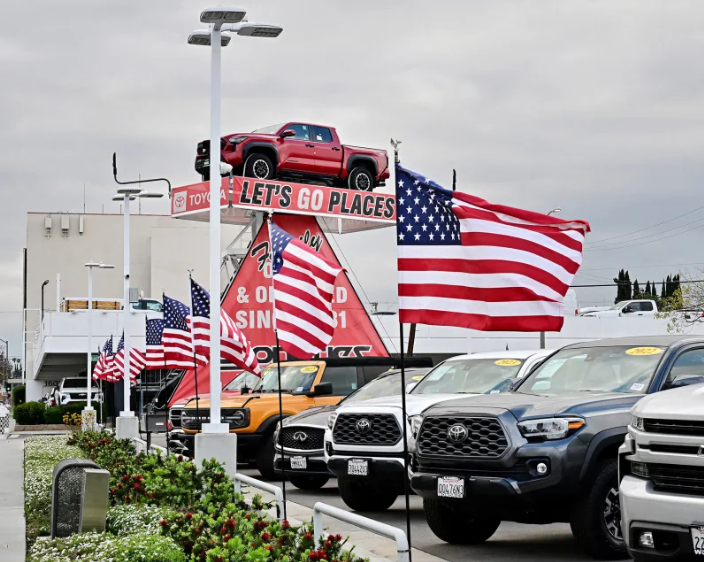Car prices are expected to increase by several thousand dollars due to Trump’s tariffs. This will occur sooner than anticipated. This is because President Donald Trump recently revealed plans for 25% tariffs on imported vehicles and components set to take effect on April 3, a decision that will raise the manufacturing costs of all cars sold in the United States – including both imports and those produced domestically – by several thousand dollars each.
If the tariffs are implemented, those added expenses will quickly elevate car prices. Past tariff proposals had been postponed or delayed on two occasions.
“I anticipate it will be costly,” stated Ivan Drury, director of insights at Edmunds.com. He noted that the price increase could be a jolting surprise that may come much earlier than most people expect, possibly even before the more expensive vehicles reach their local dealerships.
“It’s difficult to say exactly how much,” he added. “However, it is likely to be in the thousands of dollars, possibly more.”
Manufacturers may not necessarily increase their wholesale prices, which are paid by dealerships, to reflect the full cost of the tariffs, according to Drury. However, there are alternative methods to transfer those costs to consumers.
“For instance, they might eliminate certain attractive incentives,” he explained. If automakers cancel a promotion for financing at a subsidized 1.9% interest rate, it will lower their overall expenses but raise the cost for consumers by $6,000 to $7,000 per vehicle, Drury pointed out.
Despite the goal of the tariffs being to support U.S. manufacturing by encouraging consumers to buy American-made vehicles, cars manufactured in U.S. plants will still be subject to tariffs. This is due to the fact that there is no completely American-made vehicle. Last year, all 10.2 million vehicles produced in U.S. factories contained a substantial number of imported parts, primarily sourced from Canada and Mexico.
“The average domestic content is conservatively estimated to be around 50% and might be closer to 40%,” noted a fact sheet released on Wednesday by the Trump administration. Therefore, a vehicle labeled as “American” with a production cost of $40,000 could incur $5,000 in tariffs due to half of its components being from abroad.
Sticker shock
On Wednesday in the Oval Office, Trump anticipated that car prices would decrease as a result of the tariffs.
“You will see prices decline, but it will happen specifically because of incentivizing companies and even nations with firms to establish operations in America,” Trump commented.
However, industry analysts foresee the opposite: manufacturers and consumers will face rising prices. Projections on how tariffs will impact production expenses range between $3,500 and $12,000 or even more per vehicle, depending on the model, as stated by the Anderson Economic Group, a think tank based in Michigan.
“There’s likely not a single vehicle on the market today that won’t be affected in some way by tariffs,” said Peter Nagle, an automotive economist for S&P Global Mobility, during a recent CNN interview. “I would expect prices to begin to change within one to two weeks after the tariffs are implemented.”
Drury emphasized that the added cost of the tariffs is merely a part of the overall pricing narrative. Car prices are determined primarily by the millions of individual negotiations between car dealers and buyers.
“Yes, cost is a factor. However, at the end of the day, the agreed price comes down to basic economics, supply and demand,” he stated.
That’s why car prices could begin to rise even before the vehicles affected by tariffs reach your local dealership, according to Drury.
For most manufacturers other than Tesla, the dealerships negotiating with consumers are independently owned businesses that purchase vehicles at wholesale prices from automakers, determining their own pricing.
“The current stock on the dealers’ lots just increased in value,” Drury said.
Dealers who understand that their upcoming inventory will be more expensive will be less inclined to offer discounts on their existing vehicle stock, even if that inventory was unaffected by tariffs at the time of purchase.
Declining stock?
Another significant factor influencing pricing could be a notably reduced availability of vehicles.
Manufacturers are likely to decrease production as they evaluate whether the tariffs will be temporary. They may also worry that the increased costs associated with the tariffs could eliminate some potential customers. A smaller supply of new cars can inherently drive prices up.
This scenario occurred in 2021 when a shortage of computer chips severely impacted vehicle production, leading to dramatic price increases for both new and used cars.
The average transaction price surged quickly, rising by 17% for new vehicles between January and December of that year, according to data from Edmunds. Prices for used cars increased by 32% during the same time span. This time, the effects could be similarly significant.
“If the tariffs get implemented this time, we anticipate disruptions to nearly all vehicle production in North America by mid-April, resulting in a daily production decrease of 20,000 vehicles, representing a roughly 30% decline in output,” stated Jonathan Smoke, chief economist for Cox Automotive, during a media call on Wednesday. “Ultimately, we are facing reduced production, limited supply, and rising prices, similar to the situation in 2021.”
“Few thought we could sever the supply chain with Mexico and Canada, but it appears to be happening now,” he continued. “April 3rd looks like a potential doomsday if the tariffs on Mexico and Canada are imposed.”
Following a surge in vehicle purchases, auto sales are expected to decline while the prices for new and used cars will rise, with some models likely being discontinued, according to Cox Automotive.
“We’ve encountered this scenario before. During COVID, we saw supply constraints and skyrocketing costs. Although the reasons for the price increases this time are entirely different, it stands to reason that the market won’t tolerate another significant rise,” said Erin Keating, executive analyst at Cox, in a note on Friday.
The cost of a vehicle manufactured in North America—like a Ford, Chrysler, GM, or Honda—could rise between $4,000 and $10,000, according to a February estimate from the Anderson Economic Group based in Michigan. An electric vehicle could see an increase of at least $12,000.
Miguel Colom, a Bethlehem, Pennsylvania resident, expressed to CNN that he and his wife are looking to buy a Chevy Equinox EV but feel pressured to make a purchase before May due to the impending tariffs.
“A price hike of $12,500 on the vehicle we selected would likely eliminate it from our options, forcing us to make a purchase decision with less financial flexibility than we had anticipated,” he wrote in an email to CNN. Colom mentioned that even a slight increase would make them hesitant to buy a new vehicle.
While concerns have centered around the prices of new cars, the cost of maintaining older models has also troubled some Americans.
Robert Wyatt from New Jersey told CNN he traded in his 9-year-old vehicle, a Mercedes GLE-350, for a new Toyota. Although he intended to buy a car in the next two years, he opted for a purchase sooner due to Trump’s tariff proposals.
“Things start to fail,” he said regarding his prior vehicle. “I was worried about maintenance. With a new car, I won’t have to think about repairs for a couple of years.”
Sales managers informed CNN they are receiving more inquiries, though a significant spike in sales has not yet occurred. Tom Tatich, the general manager of a Toyota dealership in Marysville, Washington, remarked that customers are anxious about future car prices.
Tatich believes that high demand and limited supply have been ongoing challenges for Toyota. He is confident that demand will stay steady once tariffs take effect, and he noted that customers are attempting to secure current prices for vehicles that have not yet arrived.
“There are customers who want to make sure the prices quoted on incoming vehicles won’t change,” he clarified.
Cox Automotive reported that online traffic on both its Kelley Blue Book and Autotrader.com websites grew by 30% between Wednesday—when the tariffs were announced—and Monday, compared to the same timeframe last year. Additionally, the websites managed for hundreds of individual dealerships across the country experienced an average traffic increase of 20%.
Moreover, searches for typically considered import brands, such as Toyota, Honda, Hyundai, and Volkswagen, received two to four times more searches than domestic brands, like Chevrolet, Ford, Jeep, and Dodge. Many foreign brand models may be produced in U.S. factories, while some domestic brand models are assembled in Canada and Mexico.
The absence of clear reassurances from Trump has done little to alleviate uncertainty. In a phone interview with NBC News’ Kristen Welker on Saturday, Trump indicated he supports price hikes on foreign vehicles because “if the prices on foreign cars rise, they will opt for American cars.”
Fewer cars and escalating prices
Automakers are more inclined to reduce production as they wait to determine whether Trump’s tariffs will remain in place, which would lead to dwindling inventory. With decreased supply, dealerships are likely to increase prices in the months ahead. There are also industry concerns regarding a potential drop in customer numbers.
Trump has frequently suggested tariff measures since he took office, with the initial proposals for Canada and Mexico originally slated for early February, only to be postponed to March and then to early April. He later announced new 25% tariffs on all car imports and automotive parts, such as engines and transmissions.
While Trump has stated he will not delay the tariffs again for the automotive sector, he could change his position before or after the tariffs are enacted. Automakers are cautiously navigating this uncertainty by postponing production, while buyers are holding onto their vehicles, contributing to reduced supply and higher prices.



